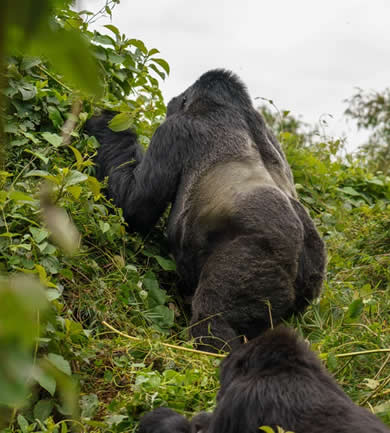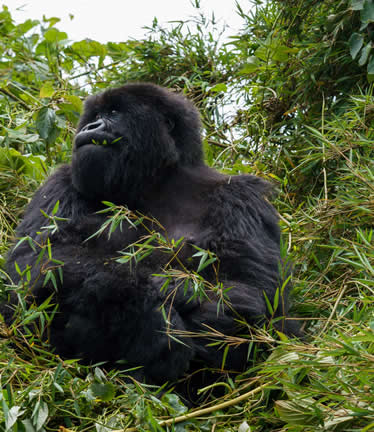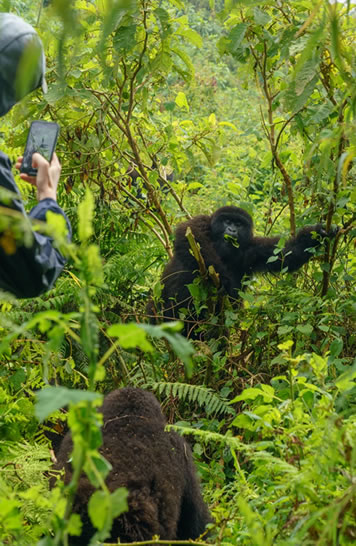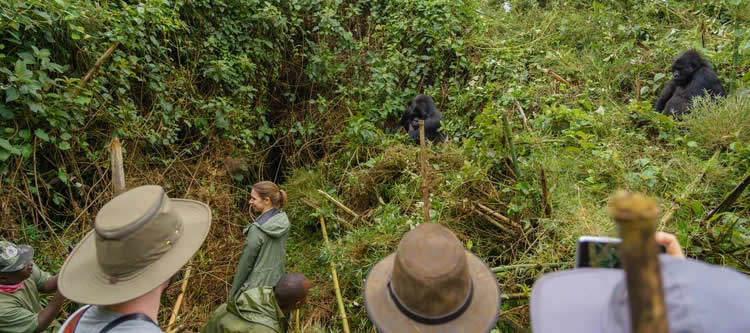Volcanoes national park in Rwanda, is a tropical rain forest is characterized two dry seasons and two rain seasons. The dry season runs from December to March. The rain season comes in normally shorter from April to May, followed by a long dry season from June – October. November is a rainy season.

Located at a high altitude covered with a tropical forest cover, Volcanoes national park receives short rains during the dry seasons to give a cool atmosphere all year round.
The best time for gorilla trekking is during the months of the dry season to avoid strong rains and slippery grounds while trekking through the bamboo forest in search for the rare mountain gorillas
Unlike traditional wildlife safaris in Rwanda, gorilla trekking is a deeply immersive and active adventure led by expert guides that takes you through dense forests and rugged terrain. A dry weather gives tourists a great opportunity to witness the fascinating behavior of mountain gorillas, from their social interactions to their feeding habits and the intricate dynamics within their troops.
What sets gorilla trekking apart is the feeling of connection to both nature and the gorillas themselves. Being in the presence of these majestic creatures is awe-inspiring, and it fosters a deep appreciation for wildlife conservation. The controlled nature of these encounters, with strict visitor numbers and behavior regulations, ensures that the gorillas are protected and minimally impacted by human presence. This balance between adventure and conservation makes gorilla trekking an exceptional experience.
Why the Dry Season is Ideal for Trekking
Gorilla trekking during the dry season offers numerous advantages, making it the preferred time for most adventurers. Explained below are some of the reasons why you should opt to go for gorilla trekking during the dry season.
Better Visibility and Photography Opportunities in the Dry Season
One of the most rewarding aspects of gorilla trekking is capturing the awe-inspiring moments on camera. The dry season is undoubtedly the best time for photography enthusiasts to take stunning photos of the gorillas and their habitat. Heavy rains, mist, and dense cloud cover can make getting clear, well-lit shots in the wet season challenging. Not only can rain damage equipment, but the low light conditions in a damp forest can lead to blurry or underexposed images.
During the dry season, visibility is much better, both for your viewing pleasure and for photography. With fewer clouds and clearer skies, the forest canopy allows more natural light to filter through, creating the perfect setting for photography. The dry, stable conditions also mean you can focus more on framing the perfect shot than protecting your gear from moisture.
Also, gorillas are more active and visible in the dry season. They move into more open areas of the forest, where the trees are less dense, giving trekkers better-unobstructed views. This is especially important for capturing images of entire gorilla families or documenting specific behaviors like grooming, feeding, or playing. The dry season’s favorable conditions allow photographers to capture the finer details of gorilla life—facial expressions, interactions, and even the texture of their fur—in a way that may be more difficult in the rainy months.
Beyond just the gorillas, the dry season offers excellent opportunities to photograph the broader landscape. The greenery is still lush, but without the constant cloud cover and rain, it can dull the scenery. Mountains, valleys, and distant forest views can all be captured in full glory. Whether you’re an amateur with a smartphone or a professional photographer, the dry season provides optimal conditions for vividly documenting your gorilla trekking experience.
Increased Chances of Gorilla Sightings
One of the most compelling reasons to plan your gorilla trek during the dry season is the increased likelihood of spotting these magnificent creatures. While seeing gorillas is never guaranteed—after all, they live in the wild and roam freely—the dry season significantly boosts your chances of a successful sighting.
During the wet season, gorillas often retreat to lower, denser parts of the forest where food is more abundant, but the terrain is more challenging to navigate. Thick underbrush and muddy paths can make it harder for trekkers to follow them, leading to longer, more strenuous hikes. Additionally, the constant rain makes the gorillas more likely to stay in the thicker parts of the forest to stay dry, further complicating efforts to track them.
In contrast, the dry season typically sees gorillas moving higher up into the mountains, where they are easier to track and locate. With less rain, they spend more time in open spaces, moving around and foraging. This allows guides to follow their movements more accurately and quickly. The gorillas also tend to be more visible, often resting or feeding in less dense vegetation, providing better observation opportunities once you’ve located them.
Furthermore, the weather conditions during the dry season are more favourable for the guides, who rely on both their experience and environmental cues to locate the gorillas. Trails are clearer and more accessible, making it easier to cover ground and find fresh gorilla tracks. The combination of improved tracking conditions and the gorillas’ movements to higher elevations significantly increases your chances of having a memorable, close-up encounter with these incredible animals.
Ultimately, while luck always plays a role in wildlife encounters, the dry season offers the best odds of a successful and satisfying gorilla sighting, making your trekking adventure all the more rewarding.
Comfort and Safety on Dry Trails
Trekking through dense forests in search of mountain gorillas is an exhilarating adventure, but it can also be physically demanding. The condition of the trails plays a crucial role in determining how challenging the trek will be, and the dry season offers the most comfortable and safest trail conditions for travellers.
In the wet season, the trails become muddy, slippery, and difficult to navigate. Steep inclines can turn into treacherous slopes, and trekkers may need help to keep their balance, especially in the more rugged, mountainous terrain. For those not accustomed to hiking in such conditions, the risk of falls or injuries increases significantly. Additionally, wet weather can lead to fatigue more quickly, as hikers may need to exert more energy to navigate rugged terrain.
The dry season eliminates many of these challenges. Trails are firm, stable, and dry, making for a far more comfortable hiking experience. Even though some areas may still be steep or uneven, the lack of mud and moisture means you can move more quickly and easily. This reduces physical strain and allows you to focus more on the experience itself—taking in the scenery, learning from your guide, and, most importantly, enjoying your time with the gorillas.
Safety is another significant consideration. Dry trails reduce the risk of slips and falls, making the trek safer for all participants. This is especially important for older travelers or those less experienced with hiking. With fewer obstacles on the trails, the overall trekking experience becomes much more enjoyable and less physically taxing, ensuring that everyone, regardless of fitness level, can fully participate.

The dry season also makes it easier for guides and park rangers to navigate the terrain, which can be crucial in emergencies or if anyone needs assistance. Overall, the dry season provides optimal trail conditions that enhance both comfort and safety, ensuring that your gorilla trekking experience is unforgettable and enjoyable from start to finish.
Easier Travel Logistics and Accommodation Availability
One less obvious but equally important benefit of gorilla trekking in the dry season is the smoother travel experience, from your journey to the trekking destination to securing accommodations. Many regions where gorilla trekking occurs, such as Bwindi Impenetrable National Park in Uganda and Volcanoes National Park in Rwanda, are remote and can be difficult to access, particularly during the rainy season.
In the wet season, unpaved roads leading to the trekking areas can become waterlogged and impassable. Heavy rains may cause road closures or delays, making travel to your starting point unpredictable and time-consuming. Even four-wheel-drive vehicles, often necessary in these areas, can struggle with the muddy conditions. This unpredictability can lead to missed trekking permits or disruptions in your carefully planned itinerary, adding unnecessary stress to your adventure.
By contrast, the dry season brings fewer travel complications. Roads are drier, more stable, and easier to navigate, making for a smoother and more reliable journey to the trekking sites. Knowing that weather-related delays are unlikely, you can also plan your day with more certainty. This is particularly reassuring for those traveling from international destinations, as flights and transfers tend to run more smoothly in good weather.
Accommodations near the trekking areas also benefit from the dry season. Many small lodges and camps in rural areas may close during the wet season due to poor access or reduced demand. During the dry season, however, more accommodations are available, offering a range of options from budget-friendly to luxury stays. The dry weather also means you can enjoy outdoor amenities at these lodges, such as scenic views, campfires, and nature walks, without worrying about rain.
In addition, the dry season generally aligns with peak tourism periods, which means more services are operational, and travel companies, tour operators, and guides are fully staffed. While this can mean higher demand and prices, booking early ensures you secure the best options for your trip. The dry season allows for more accessible travel logistics, providing a more relaxed and enjoyable gorilla trekking experience.
Conclusion: Planning Your Gorilla Trekking Adventure
Planning a successful gorilla trekking adventure requires careful consideration, and choosing the dry season for your trip will help you get the most out of the experience. Here are some practical tips to ensure your adventure goes smoothly during this optimal time of year:
Book Your Permits Early
Gorilla trekking is a highly sought-after experience, and during the dry season, permits can sell out quickly due to higher demand. Each trekking area issues a limited number of permits daily to protect the gorillas and manage the number of visitors. To secure your spot, it’s essential to book your permit well in advance—ideally several months before your trip. Both Uganda and Rwanda offer permits, with Rwanda’s typically being more expensive.
Choose Your Trekking Location Wisely
Depending on whether you’re trekking in Uganda, Rwanda, or the Democratic Republic of Congo, the dry season conditions can vary slightly, as these countries experience somewhat different weather patterns. Uganda’s Bwindi Impenetrable Forest and Rwanda’s Volcanoes National Park are the two most popular destinations, with Rwanda known for shorter, less strenuous treks and Uganda offering more varied, rugged terrain. Consider your fitness level and preferred trekking experience when choosing your destination.
Pack the Right Gear
Trekking through forests at high altitudes can be challenging, even in the dry season. You’ll need sturdy hiking boots, breathable but protective clothing, and a good backpack. The weather can still be cool in the mornings or evenings, so layering is key. Don’t forget a lightweight rain jacket, as occasional showers can still occur. Also, bring a good camera or binoculars for excellent wildlife-viewing opportunities.
Hire a Reliable Guide and Porter
Experienced guides are critical for a successful trek. Not only do they help locate the gorillas, but they also provide valuable insights about the forest, its inhabitants, and conservation efforts. Hiring a porter is also highly recommended, especially in the dry season when temperatures can rise, and the hikes may be prolonged. Porters can carry your gear and assist with navigating tricky terrain, allowing you to focus on the experience.
Prepare for Physical Exertion
Although the dry season makes trekking easier, being physically prepared is still essential. Some treks can last anywhere from one to several hours, depending on where the gorillas are located. Preparing your body with regular exercise—especially hiking or walking on uneven terrain—will help you enjoy the trek to its fullest without feeling overwhelmed by the physical demands.
Respect Gorilla Trekking Etiquette
Trekking in the dry season often brings more tourists, so it’s crucial to follow all rules and guidelines set by park authorities. Maintain a respectful distance from the gorillas (at least 7 meters), avoid sudden movements, and always listen to your guide’s instructions. These guidelines are essential for your safety and the well-being of the gorillas.
By planning carefully and taking advantage of the dry season’s favorable conditions, you’ll set yourself up for a rewarding and memorable gorilla trekking adventure. The combination of good weather, increased wildlife visibility, and smoother trekking conditions makes this the best time to embark on this once-in-a-lifetime experience.


Leave A Comment